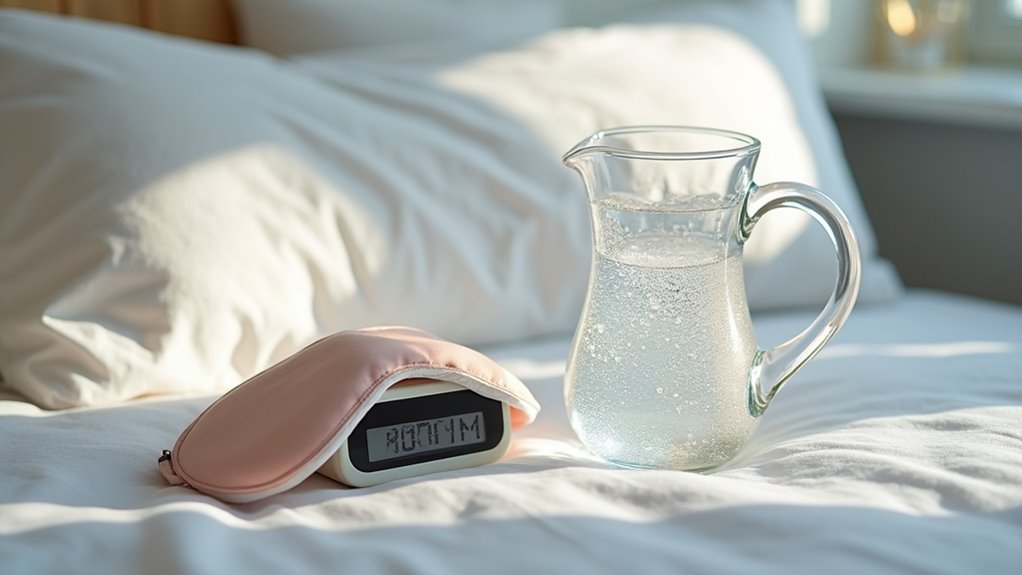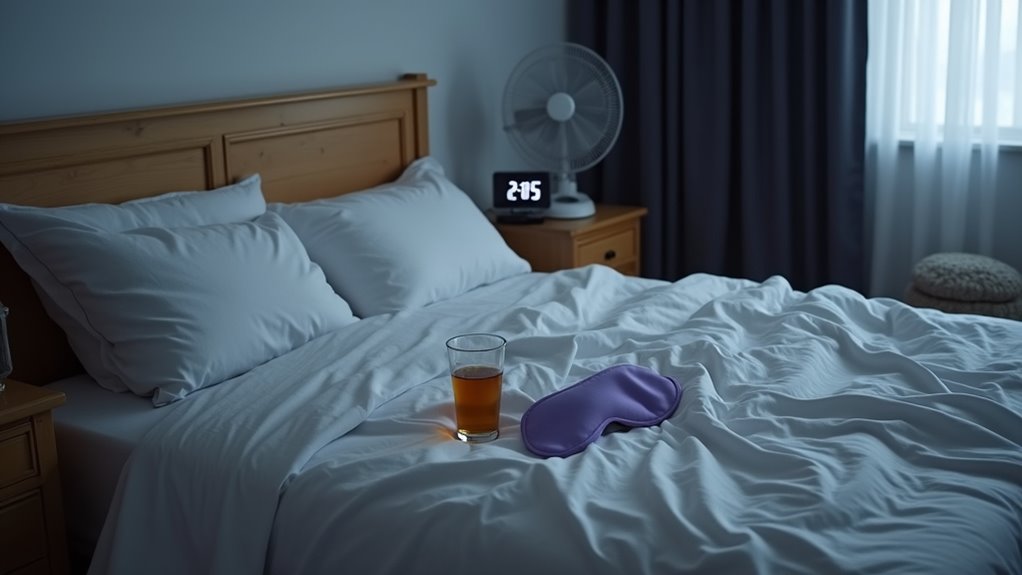To manage Suboxone side effects effectively, you’ll need to stay well-hydrated and maintain consistent sleep patterns. Take medication with small, easily digestible snacks to reduce nausea, and practice good oral hygiene to prevent dental issues. Use OTC pain relievers for headaches, implement stress reduction techniques, and track your essential signs regularly. Monitor and document any side effects, maintain proper medication storage, and work closely with your healthcare provider. Understanding these foundational strategies opens the door to more advanced management techniques.
Staying Hydrated and Well-Rested

While taking Suboxone as part of your treatment plan, maintaining proper hydration and getting adequate rest becomes especially critical for managing potential side effects.
During treatment, the long half-life of Suboxone means your body needs consistent support through proper hydration and rest to process the medication effectively.
Due to limited research specifically addressing hydration and rest during Suboxone treatment, you’ll need to work closely with your healthcare provider to develop personalized strategies. They can help you monitor your proper hydration levels and establish healthy sleep routines adapted to your individual needs.
Since Suboxone is considered a front-line treatment for opioid use disorder, optimizing your self-care routine is essential for long-term success. As a medication assisted treatment, Suboxone helps reduce withdrawal symptoms and cravings while your body adjusts to recovery.
Your provider may recommend tracking your daily water intake and sleep patterns to guarantee you’re maintaining adequate rest and relaxation throughout your treatment path. Since both hydration and sleep can impact your comprehensive treatment success, it’s crucial to discuss any concerns or challenges you experience in these areas with your healthcare team, allowing them to adjust your care plan accordingly.
Managing Nausea and Digestive Issues

Nausea and digestive discomfort from Suboxone can be managed through strategic meal planning and natural remedies.
You’ll find relief by consuming small snacks before dosing and choosing lighter, easily digestible foods throughout the day. Most patients experience less severe symptoms as their body adjusts to the medication over time. Taking Suboxone on an empty stomach often worsens nausea symptoms. Natural solutions like aromatherapy with peppermint oil and controlled breathing techniques can help reduce nausea symptoms when they occur. Taking antiemetic medications prescribed by your healthcare provider can provide additional relief from persistent nausea.
Natural Anti-Nausea Solutions
Managing digestive discomfort during Suboxone treatment often begins with natural remedies that can effectively reduce nausea. You’ll find several evidence-based options, including herbal supplements and ginger remedies, that complement your prescribed treatment plan. When combined with proper rest and hydration, these natural solutions can help minimize gastrointestinal side effects while maintaining treatment efficacy. Taking Suboxone with food can help reduce initial nausea. For severe cases of nausea, your doctor may recommend anti-nausea medication to help manage symptoms.
Keep ginger tea or candies readily available to calm stomach upset between doses. Practice deep breathing exercises in a quiet environment to reduce stress-induced nausea. Try peppermint or chamomile tea 30 minutes before taking your medication. Use aromatherapy with essential oils like lemon or lavender to ease discomfort. Incorporate acupressure wristbands designed for motion sickness relief.
Remember to discuss any natural remedies with your healthcare provider to guarantee they won’t interfere with your treatment protocol.
Meal Planning For Relief
Effective meal planning serves as a cornerstone in minimizing Suboxone-related digestive issues. You’ll need to focus on appetite regulation and timing meal dosing to prevent nausea and maintain comfort throughout your treatment. Taking medication on an empty stomach may increase the speed of absorption but can worsen nausea symptoms. Taking Suboxone with small frequent meals helps reduce gastrointestinal side effects. Since the medicine needs to dissolve under tongue, avoid eating or drinking during administration.
| Timing | Food Choices | Action Steps |
|---|---|---|
| 20 min before dose | Light snacks | Eat toast or crackers |
| During dose | No food/drink | Let medicine dissolve |
| 30 min after dose | Start slowly | Begin with clear liquids |
Consider breaking your daily intake into 4-5 smaller meals to ease digestive strain. You’ll want to prioritize bland, fiber-rich foods while avoiding spicy or fatty options that could trigger discomfort. If you’re experiencing persistent nausea, your healthcare provider might suggest adjusting your dosing schedule or splitting doses to better align with your meal timing.
Coping With Headaches and Dizziness

When headaches and dizziness occur during Suboxone treatment, several evidence-based strategies can help alleviate these common side effects. Start by avoiding caffeine withdrawal and maintain proper hydration with 8-10 glasses of water daily. While exploring acupuncture relief, you’ll find it can reduce tension and improve circulation. For immediate relief, try OTC medications like ibuprofen or acetaminophen when medically approved, but avoid aspirin due to bleeding risks. Relaxation techniques have been proven effective for managing Suboxone-related discomfort. Keep in mind that orthostatic hypotension can worsen dizziness when standing up too quickly.
Practice mindfulness techniques and deep breathing exercises to manage stress-induced symptoms. Maintain consistent sleep schedules and gentle exercise routines like yoga. Take medications with adequate fluids to combat dehydration. Eat regular, nutrient-rich meals to stabilize blood sugar levels. Consult your healthcare provider if symptoms persist or worsen.
Maintaining Good Oral Health
While headaches and dizziness require careful management, the oral health risks of Suboxone demand equal attention. You’re at higher risk for dental problems due to the medication’s sugar content and its tendency to cause dry mouth. Research shows that sublingual buprenorphine/naloxone users have significantly higher rates of dental problems compared to those using other forms of treatment. The risks can emerge within two weeks of starting treatment.
Prolonged use without monitoring often leads to severe dental decay requiring extensive work like root canals and crowns. To protect your teeth, brush twice daily with fluoride toothpaste, focusing on areas where the medication dissolves. Consider tongue scraping benefits for better oral hygiene, and implement tooth remineralization strategies through fluoride varnishes and rinses. Always rinse with water after your dose, and maintain regular dental visits every six months. Tell your dentist about your Suboxone use, as they’ll need to tailor your treatment plan accordingly. If you experience persistent dental issues, discuss alternative formulations with your prescriber.
Establishing Healthy Sleep Patterns
Establishing a consistent bedtime routine can dramatically improve your sleep quality while taking Suboxone, as it helps regulate your body’s natural circadian rhythm.
You’ll need to create a sleep-friendly environment by maintaining ideal bedroom temperature (60-67°F), using blackout curtains, and removing electronic devices that emit blue light.
The timing of your exercise matters too engaging in moderate physical activity during daylight hours can boost your sleep architecture, but you should avoid vigorous workouts close to bedtime.
Consistent Bedtime Routine Matters
A consistent bedtime routine plays an essential role in managing Suboxone’s effects on sleep architecture. By establishing fixed sleep-wake patterns, you’ll support proper circadian rhythm maintenance and minimize disruptions to your REM cycles.
The importance of consistency extends beyond just bedtime it encompasses pre-sleep activities that signal your body it’s time to wind down.
- Dedicate 30 minutes before bed to calming activities like reading or meditation to counteract CNS effects
- Eliminate screen exposure one hour before sleep to protect natural melatonin production
- Practice gentle stretching exercises to release muscle tension and promote relaxation
- Maintain consistent meal times and evening routines to reinforce your body’s natural sleep cues
- Avoid stimulating activities, caffeine, and alcohol in the hours leading up to bedtime
Create Sleep-Friendly Environment
Creating an ideal sleep environment proves essential for patients managing Suboxone treatment and its effects on sleep quality. To optimize your sleep space, focus on ambient temperature adjustments by maintaining your bedroom between 60-67°F, which research shows promotes better rest. You’ll also need to minimize light exposure through blackout curtains and establish screen-free zones to reduce disruptive blue light.
Consider investing in a white noise machine to mask environmental sounds and create a consistent audio backdrop. Your bedding and mattress quality directly impact sleep success replace uncomfortable materials that might interfere with rest. Implementing these environmental modifications, combined with proper sleep hygiene practices, can help counteract Suboxone-related sleep disturbances and support your recovery endeavor.
Exercise Timing Affects Sleep
While managing Suboxone treatment, strategic exercise timing plays an essential role in regulating your sleep-wake cycle. For ideal circadian rhythm optimization, morning workouts have shown superior benefits, reducing cortisol levels and improving sleep quality.
If you can’t exercise in the morning, evening workouts remain beneficial when properly timed, ideally 1-2 hours before bedtime to allow your core body temperature to normalize.
- Morning exercise boosts evening melatonin production, particularly with hypoxic exercise benefits
- High-intensity workouts require longer recovery windows to prevent sleep disruption
- Consistent morning exercise routines over 6-12 weeks yield the most significant sleep improvements
- Evening exercise won’t harm sleep quality if you allow proper cooling-down time
- Moderate-intensity activities can improve sleep scores regardless of timing, though morning sessions show amplified benefits.
Implementing Exercise and Movement Strategies
Three key components make exercise an essential part of managing Suboxone side effects: physical symptom relief, emotional stability, and cognitive improvement. You’ll find that strategic movement helps in elevating energy levels while regulating mood fluctuations during treatment.
| Activity Type | Benefits | Recommended Frequency |
|---|---|---|
| Low-impact cardio | Reduces fatigue, improves mood | 3-4x weekly |
| Strength training | Builds muscle, increases energy | 2-3x weekly |
| Yoga/stretching | Eases muscle tension, anxiety | Daily |
| Mind-body exercises | Amplifies focus, reduces stress | 2-3x weekly |
| Walking | Promotes digestion, sleep quality | Daily |
Start with gentle exercises and gradually increase intensity based on your energy levels. Monitor your body’s response and adjust workouts accordingly, especially during tapering periods. Always maintain proper hydration and consult your healthcare provider before starting any exercise routine.
Building Emotional Support Systems
Building a sturdy emotional support system proves essential for successful Suboxone treatment, with research showing that patients who maintain strong support networks are twice as likely to achieve sustained recovery. Through building social networks and strengthening self-esteem, you’ll develop crucial coping mechanisms while traversing treatment challenges.
Join peer-led support groups like AA/NA to connect with others who understand your odyssey and provide accountability. Engage in professional therapy to develop personalized strategies for managing emotional triggers. Participate in structured recovery programs that combine skill-building workshops with peer mentoring. Practice communication and boundary-setting exercises to improve relationships and protect your well-being. Maintain regular contact with your medical team to optimize treatment outcomes and address concerns promptly.
Monitoring Physical Health Markers
Regular monitoring of your essential signs, including blood pressure, heart rate, and respiratory rate, helps detect early warning signs of adverse reactions to Suboxone. You’ll need to track these measurements daily and report significant changes to your healthcare provider immediately.
Your blood test results, particularly liver function tests and buprenorphine metabolite levels, provide critical data about your body’s response to treatment and help your provider optimize your dosing schedule.
Track Vital Signs Daily
Monitoring essential signs daily serves as a critical safeguard for patients taking Suboxone, as these measurements can reveal early warning signs of adverse reactions or complications. Through consistent respiratory function monitoring and autonomic response tracking, you’ll be able to identify potential issues before they become severe.
Check your breathing rate regularly, aiming for 12-20 breaths per minute, and note any episodes of shallow or irregular breathing. Monitor oxygen saturation levels using a pulse oximeter to detect early signs of respiratory depression. Track changes in pupil size and responsiveness, as these can indicate medication effects.
Document sweating patterns, skin temperature, and “goosebump” occurrences as withdrawal markers. Record instances of drowsiness, coordination problems, or unusual behavioral changes that might suggest dosing adjustments.
Monitor Blood Test Results
To guarantee optimal treatment outcomes, blood test monitoring plays a critical role in Suboxone therapy by providing objective data about medication levels and metabolites in your system. When monitoring buprenorphine levels, your healthcare provider will track both the parent drug and its metabolites using specialized testing methods.
| Test Parameter | Clinical Significance |
|---|---|
| Peak Levels | Occurs 1-4 hours after dose |
| Detection Window | Remains detectable 1-2 days |
| Metabolite Analysis | Reveals metabolism patterns |
Interpreting blood test results requires consideration of multiple factors, including your dosing schedule and individual metabolism. Your provider will use high-performance liquid chromatography and mass spectrometry to ensure accurate measurements. These tests help validate medication adherence, guide dose adjustments, and prevent potential complications. Regular monitoring also helps distinguish Suboxone from other opioids, avoiding false-positive results.
Creating Safe Medication Routines
Establishing safe medication routines for Suboxone treatment requires careful attention to dosing schedules, storage protocols, and withdrawal monitoring. You’ll need to focus on maintaining secure storage in labeled containers and preventing dosage errors through careful tracking. Create a structured routine that aligns with your prescribed schedule, taking doses only when experiencing moderate to severe withdrawal symptoms.
Use a medication calendar or digital app to log your doses and withdrawal symptoms. Store Suboxone in its original packaging in a secure location away from children and pets. Take sublingual films/tablets whole – never chew, crush, or swallow them. Monitor and document any side effects to discuss with your healthcare provider. Adjust dosing times based on your withdrawal patterns, but never exceed prescribed limits.
These practices help optimize your treatment outcomes while maintaining safety standards and reducing risks of medication errors.
Developing Stress Management Techniques
Effective stress management plays a vital role in supporting your Suboxone treatment success. By adopting mindful journaling practices, you can track emotional triggers and identify patterns that may impact your recovery path. Combine this self-awareness with physical activities like walking or yoga to naturally reduce stress through endorphin release.
Your nutrition choices directly affect your emotional stability during treatment. Focus on whole foods, stay hydrated, and limit substances that could intensify stress responses. When you feel overwhelmed, utilize the 4-4-4 breathing technique to quickly calm your nervous system.
Incorporating therapy techniques, such as CBT, alongside these body-based approaches helps build extensive coping skills. You’ll strengthen your resilience by consistently practicing these strategies while reframing negative thought patterns that could otherwise trigger stress responses.
Frequently Asked Questions
Can Suboxone Affect My Ability to Drive or Operate Machinery Safely?
Yes, Suboxone can drastically impact your ability to drive safely or operate machinery. Research shows you’re twice as likely to cause crashes while taking this medication.
You’ll need to follow safe driving guidelines, especially during early treatment or dose adjustments. Be aware that combining Suboxone with alcohol increases crash risk by 21.89x. Don’t operate machinery until you understand how the medication affects you and your doctor confirms it’s safe.
How Long Do Side Effects Typically Last When Starting Suboxone Treatment?
When you start Suboxone treatment, preliminary withdrawal symptoms typically emerge within 24-72 hours and peak around day 3. You’ll likely experience the most intense effects during the initial week, with symptoms gradually subsiding over 5-7 days.
While acute physical symptoms generally resolve within a week, some psychological effects may persist longer. Long-term treatment adjustments might be necessary over several weeks or months as your body fully adapts to the medication.
Will Suboxone Interact With My Vitamins or Herbal Supplements?
While most vitamins don’t show significant interactions with Suboxone, you should still be cautious with supplement interactions.
Herbal supplements, particularly St. John’s Wort, can pose serious risks by reducing Suboxone’s effectiveness or causing dangerous side effects.
Don’t start any vitamins or supplements without initially consulting your healthcare provider. They’ll need to evaluate potential vitamin impacts and supplement interactions to safeguard your safety during Suboxone treatment.
Can I Get Pregnant While Taking Suboxone?
Yes, you can get pregnant while taking Suboxone. The medication doesn’t affect your fertility or menstrual cycle changes, and you’ll need to use effective birth control if you’re not planning a pregnancy.
While there are fetal development concerns to ponder, research shows Suboxone is safer during pregnancy than other opioids. If you’re planning to conceive, don’t stop taking Suboxone without consulting your doctor, as sudden discontinuation could be harmful.
Does Smoking Cigarettes Affect How Suboxone Works in My Body?
Yes, smoking can profoundly affect how Suboxone works in your body. When you smoke cigarettes, you’ll likely experience increased nicotine cravings while taking Suboxone, leading to more frequent smoking.
Cigarette smoke also activates certain liver enzymes that can speed up how quickly your body processes Suboxone, potentially making it less effective.
Moreover, both substances interact with your brain’s reward pathways, which may intensify withdrawal symptoms if you try to quit either one.

